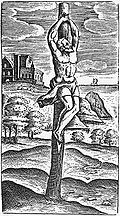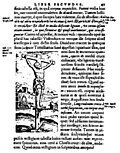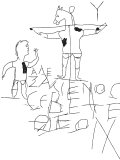Crucifixion
Crucifixion is a method of capital punishment where the victim is tied or nailed to a large wooden beam and left to hang, possibly for several days, until eventual death from exhaustion and asphyxiation. It has been used in various parts of the world and is most famous for its use by the Roman Empire, which crucified the Jesus of Nazareth.
History[edit]
Crucifixion was used among the Seleucids, Carthaginians, and Romans from about the 6th century BC to the 4th century AD. In the year 337, Emperor Constantine the Great abolished it in the Roman Empire out of veneration for Jesus Christ, the most famous victim of crucifixion. It was also used as a form of punishment among the Persians, Indians, Assyrians and Scythians.
Procedure[edit]
The condemned was usually stripped naked and scourged, a process which involved a short whip with several single or braided leather thongs of variable lengths, in which small iron balls or sharp pieces of sheep bones were tied at intervals. The scourging could be severe enough to cause death.
In Christianity[edit]
In Christianity, the crucifixion of Jesus is a central event. According to the New Testament, Jesus was arrested, tried, and sentenced by Pontius Pilate to be scourged, and finally crucified by the Romans.
See also[edit]
References[edit]
<references />
|
|
|
-
Crucifixion Strasbourg Unterlinden Inv88RP536
-
Gabriel Max 1866 St Julia img02
-
Justus Lipsius Crux Simplex 1629
-
De Cruce Libri Tres 47
-
Hombre de Giv'at ha-Mivtar
-
Illustrations pour Salammbô Poirson Victor-Armand
-
Alexorig
-
AlexGraffito
-
Japanese Crucifixion
-
Martyrdom of Nagasaki Painting 1622
-
Your Liberty Bond will help stop this Crisco restoration and colours
-
Punishment China 1900
Ad. Transform your life with W8MD's Budget GLP-1 injections from $75


W8MD offers a medical weight loss program to lose weight in Philadelphia. Our physician-supervised medical weight loss provides:
- Weight loss injections in NYC (generic and brand names):
- Zepbound / Mounjaro, Wegovy / Ozempic, Saxenda
- Most insurances accepted or discounted self-pay rates. We will obtain insurance prior authorizations if needed.
- Generic GLP1 weight loss injections from $75 for the starting dose.
- Also offer prescription weight loss medications including Phentermine, Qsymia, Diethylpropion, Contrave etc.
NYC weight loss doctor appointmentsNYC weight loss doctor appointments
Start your NYC weight loss journey today at our NYC medical weight loss and Philadelphia medical weight loss clinics.
- Call 718-946-5500 to lose weight in NYC or for medical weight loss in Philadelphia 215-676-2334.
- Tags:NYC medical weight loss, Philadelphia lose weight Zepbound NYC, Budget GLP1 weight loss injections, Wegovy Philadelphia, Wegovy NYC, Philadelphia medical weight loss, Brookly weight loss and Wegovy NYC
|
WikiMD's Wellness Encyclopedia |
| Let Food Be Thy Medicine Medicine Thy Food - Hippocrates |
Medical Disclaimer: WikiMD is not a substitute for professional medical advice. The information on WikiMD is provided as an information resource only, may be incorrect, outdated or misleading, and is not to be used or relied on for any diagnostic or treatment purposes. Please consult your health care provider before making any healthcare decisions or for guidance about a specific medical condition. WikiMD expressly disclaims responsibility, and shall have no liability, for any damages, loss, injury, or liability whatsoever suffered as a result of your reliance on the information contained in this site. By visiting this site you agree to the foregoing terms and conditions, which may from time to time be changed or supplemented by WikiMD. If you do not agree to the foregoing terms and conditions, you should not enter or use this site. See full disclaimer.
Credits:Most images are courtesy of Wikimedia commons, and templates, categories Wikipedia, licensed under CC BY SA or similar.
Translate this page: - East Asian
中文,
日本,
한국어,
South Asian
हिन्दी,
தமிழ்,
తెలుగు,
Urdu,
ಕನ್ನಡ,
Southeast Asian
Indonesian,
Vietnamese,
Thai,
မြန်မာဘာသာ,
বাংলা
European
español,
Deutsch,
français,
Greek,
português do Brasil,
polski,
română,
русский,
Nederlands,
norsk,
svenska,
suomi,
Italian
Middle Eastern & African
عربى,
Turkish,
Persian,
Hebrew,
Afrikaans,
isiZulu,
Kiswahili,
Other
Bulgarian,
Hungarian,
Czech,
Swedish,
മലയാളം,
मराठी,
ਪੰਜਾਬੀ,
ગુજરાતી,
Portuguese,
Ukrainian















